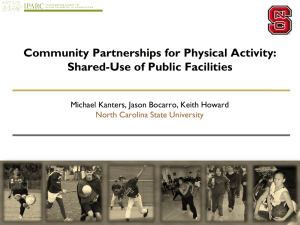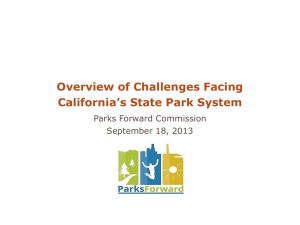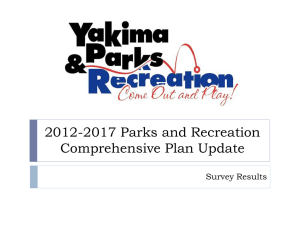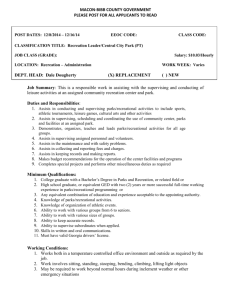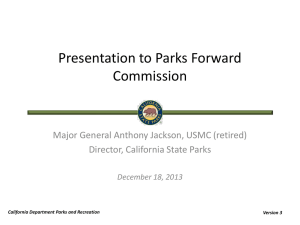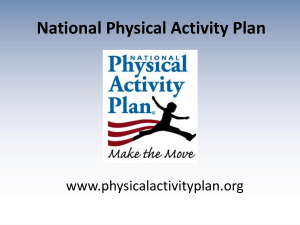NRPA 2015 Park and Recreation Month Key Messages
advertisement
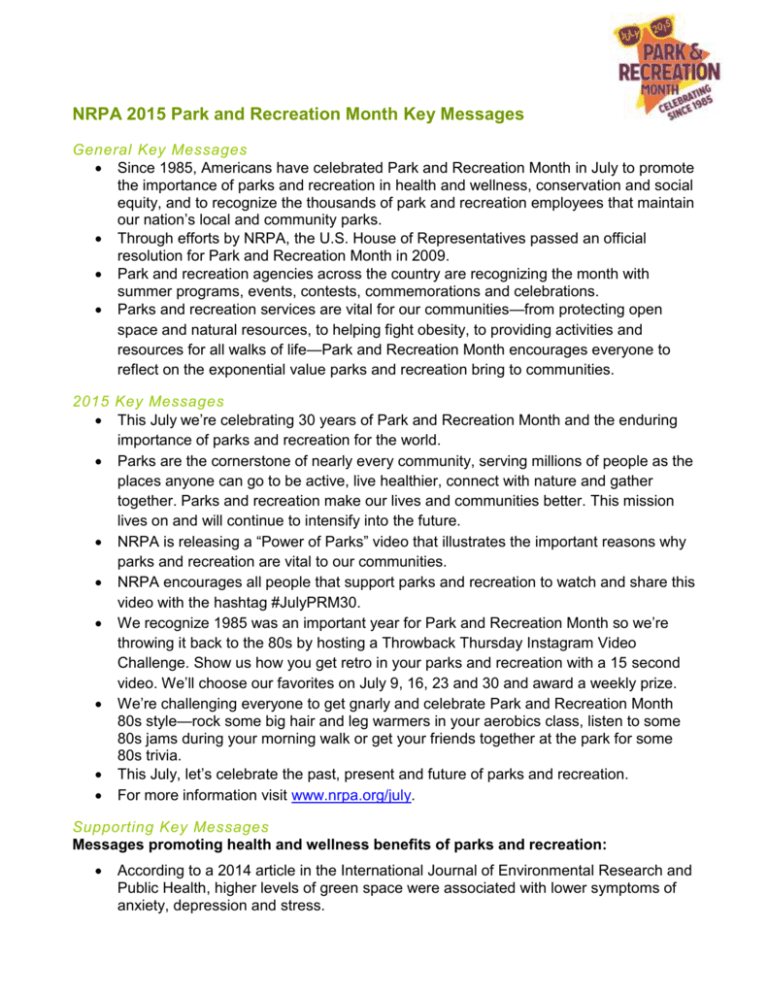
NRPA 2015 Park and Recreation Month Key Messages General Key Messages Since 1985, Americans have celebrated Park and Recreation Month in July to promote the importance of parks and recreation in health and wellness, conservation and social equity, and to recognize the thousands of park and recreation employees that maintain our nation’s local and community parks. Through efforts by NRPA, the U.S. House of Representatives passed an official resolution for Park and Recreation Month in 2009. Park and recreation agencies across the country are recognizing the month with summer programs, events, contests, commemorations and celebrations. Parks and recreation services are vital for our communities—from protecting open space and natural resources, to helping fight obesity, to providing activities and resources for all walks of life—Park and Recreation Month encourages everyone to reflect on the exponential value parks and recreation bring to communities. 2015 Key Messages This July we’re celebrating 30 years of Park and Recreation Month and the enduring importance of parks and recreation for the world. Parks are the cornerstone of nearly every community, serving millions of people as the places anyone can go to be active, live healthier, connect with nature and gather together. Parks and recreation make our lives and communities better. This mission lives on and will continue to intensify into the future. NRPA is releasing a “Power of Parks” video that illustrates the important reasons why parks and recreation are vital to our communities. NRPA encourages all people that support parks and recreation to watch and share this video with the hashtag #JulyPRM30. We recognize 1985 was an important year for Park and Recreation Month so we’re throwing it back to the 80s by hosting a Throwback Thursday Instagram Video Challenge. Show us how you get retro in your parks and recreation with a 15 second video. We’ll choose our favorites on July 9, 16, 23 and 30 and award a weekly prize. We’re challenging everyone to get gnarly and celebrate Park and Recreation Month 80s style—rock some big hair and leg warmers in your aerobics class, listen to some 80s jams during your morning walk or get your friends together at the park for some 80s trivia. This July, let’s celebrate the past, present and future of parks and recreation. For more information visit www.nrpa.org/july. Supporting Key Messages Messages promoting health and wellness benefits of parks and recreation: According to a 2014 article in the International Journal of Environmental Research and Public Health, higher levels of green space were associated with lower symptoms of anxiety, depression and stress. The Centers for Disease Control found that increased access to places for physical activity led to a 25.6 percent increase in people exercising 3 or more times per week. Living close to parks and other recreation facilities is consistently related to higher physical activity levels for both adults and youth. On average, children who live in greener environments weigh less than children who live in less green areas. Children that have easy access to a playground are approximately five times more likely to have a healthy weight than children that do not have easy access to playgrounds. The nation’s park and recreation facilities are on the frontline in the battle against the obesity epidemic and other chronic health issues. Between 2000 and 2012, more than 85 studies have been published that link parks to better physical and mental health. Messages promoting environmental benefit of parks and recreation: Parks, and particularly the trees in parks, have a direct and important impact on our quality of life. In fact, a 2006 study found that the air pollution removal value by urban trees in the United States is estimated to be 1.56 billion pounds per year – a value of $3.8 billion. A park with one acre of trees absorbs the carbon dioxide produced by driving a car 11,000 miles. Parks do a great deal to contribute to species richness in urban settings – a review of more than 60 studies by IFPRA shows that there is strong evidence to support the concept that parks support both plant and animal biodiversity. This offers not only important educational opportunity, but additionally supports overall ecosystem functionality. Parks reduce the impact of large storms and flooding by serving as sponges that soak up run off from nearby paved surfaces during rain events. This in turn prevents flooding, and decreases property damage. Parks that are well-designed also reduce water usage by recycling and storing this water for use during times of low precipitation. Evidence not only shows that parks are cooler than their surrounding cities, but actually shows that parks contribute to overall urban cooling – parks make our cities more comfortable in the summer! Messages promoting the economic benefits of parks and recreation: 2 According to the National Association of State Park Directors, 725 million people visited state parks in 2013. State parks cost $2.3 billion to operate, but they inject more than $20 billion into local economies. According to studies from the Trust for Public Land, five park systems located throughout the U.S. provided more than $5.4 billion in economic value.

